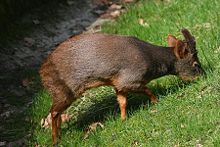Laguna San Rafael National Park
|
Laguna San Rafael National Park
|
||
|
Campo de Hielo Norte glacier area |
||
| location | Chile | |
| surface | 17,420 km² | |
| WDPA ID | 83 | |
| Geographical location | 47 ° 0 ′ S , 74 ° 0 ′ W | |
|
|
||
| Setup date | 1959 | |
| administration | Corporación Nacional Forestal | |
The National Park Laguna San Rafael ( Spanish Parque Nacional Laguna San Rafael ) is located in Chile in the Región de Aisén . He is a biosphere reserve of UNESCO .
geography
The national park is 120 km south of Puerto Chacabuco and has an area of 17,420 km², the highest mountain is Monte San Valentín with a height of 4058 meters. Much of the national park is located on the Taitao Peninsula . The huge glaciated areas of the northern Patagonian ice field ( Campo de Hielo Norte ) lie on the Chilean mainland .
The journey is usually made via Coyhaique by plane and then to Puerto Aysén . Then it goes by ferry over Puerto Chacabuco to the San Rafael glacier . The main tourist destination is the glacier about 50 km west of Mount San Valentín. Here the huge glacier flows into the Laguna San Rafael. It is part of the northern ice field (Campo de Hielo Norte). It is the glacier closest to the equator, which flows into a body of water. The glacier is 45 km long and 2.5 km wide. The glacier walls can be over 70 m high. Tourists are brought close by boat. However, it is dangerous to drive too close to the glacier, as the breaking ice masses can trigger large tidal waves. The glacier is one of the fastest flowing ice streams on earth. At the end of the 19th century, the San Rafael glacier was still a Piedmont glacier , the ice of the glacier spreads far into the Laguna San Rafael. Since then it has lost about 11.5% of its area, the glacier tongue no longer extends into the laguna.
In 1960 the soil in the area sank as a result of the Valdivia earthquake . Since then, the Laguna San Rafael has been connected to the Pacific via the Río Témpanos (English: "Iceberg River").
The area is very rainy with a rainfall of up to 5000 millimeters per year, and with an average temperature of 5 ° C quite cold.
flora
Due to the climate, only a few tree species grow in the huge park. The most important tree species are Magellan and Coihue southern beech , Chilean stone beech , shiny southern beech , trees of the families Winteraceae and Atherospermataceae , Chilean river cedar , Lenga southern beech and cypress . Occurring shrubs are Desfontainia spinosa , box-leaved barberry , scarlet fuchsia and various heather plants .
fauna
Mainly seabirds and enormous fish populations live here, larger mammals are seldom found due to the temperatures. Occurring birds are black-necked swans , gulls of the genus Larus , condors , cormorants , red-throated tapaculos and black-throated rumpets. Among the mammals there are pudus , they are the smallest deer in the world. In addition, live Chilean Forest Cats , marine otter , Andean deer and Andean jackals in the national park.
history
The Laguna San Rafael National Park was established in 1959 and is subordinate to the Chilean forest authority CONAF . UNESCO declared the national park a biosphere reserve in 1979.
Web links
Individual evidence
- ↑ a b Laguna San Rafael. UNESCO, accessed on August 20, 2012 .
- ^ Kathryn Hansen: Melting beauty: The Patagonian icefields. NASA Earth Observatory, July 11, 2018, accessed July 15, 2018 .
- ^ Patagonian ice in rapid retreat. BBC News, accessed August 20, 2012 .
- ^ A b North Patagonian Icefield. NASA Earth Observatory, April 11, 2017, accessed July 15, 2018 .
- ↑ Clima en Laguna San Rafael. lagunasanrafael.info, archived from the original on September 25, 2013 ; Retrieved August 20, 2012 (Spanish).
- ↑ 'Reforestemos Chile' starts Patagonia reforestation program. Patagon Journal, accessed August 20, 2012 .
- ↑ a b c d Parque Nacional Laguna San Rafael. conaf.cl, archived from the original on March 30, 2013 ; Retrieved September 13, 2012 (Spanish).
- ↑ Laguna San Rafael National Park. gochile.cl, accessed on August 20, 2012 .
- ^ Southern Pudu. Animal Planet , accessed September 13, 2012 .



